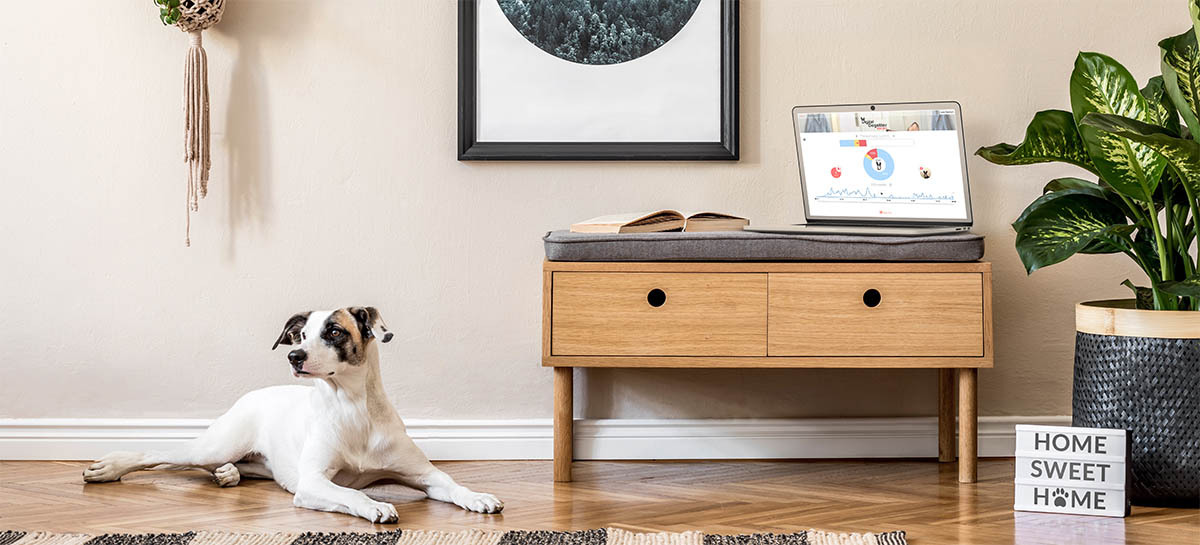The test that assesses your dog’s wellbeing may advise you not to use the Your voice feedback feature. Voice feedback can be a great tool, but in certain situations, it is not recommended. There may be several such situations, and in some, feedback audio clips may even be harmful. Here, we describe the most common reasons why it may not be recommended to experiment with Your voice feedback.
If you are particularly interested in using voice feedback, you can safely try it regardless of the test result. This is because we have introduced a remote control feature for the Digital Dogsitter that allows you to monitor your dog remotely and, if necessary, turn off voice feedback if it appears to be making your dog more nervous.
Before using the feature, however, please ensure you read the instructions for Using Voice Feedback in Dog Training and How to use the remote control.
Here are some situations in which voice feedback may not work as desired
- Dogs that experience fear or anxiety when left alone
- Dogs that bark often to get their owner’s attention
- Dogs that bark at sounds coming from outside the home, even when the owner is present, and do not calm down when instructed
- Dogs whose learning history contains exercises that may result in barking at voice feedback audio clips
In the following sections, you will find more information about using voice feedback in the above situations. At a minimum, you should monitor your dog during the first session they are left alone with voice feedback, to ensure that the feature has a positive effect on the dog's state of mind.
Dogs that experience fear or anxiety while being alone
The use of voice feedback is unfortunately not a solution for fearful dogs. The owner’s voice can make the dog strive even harder to get to them. In a fearful state, the dog is unlikely to recognize the instruction to calm down and may, for example, think the owner is nearby. Because it’s uncertain how the voice feedback clip will affect the dog – and their overall well-being may be compromised due to fear and possible escape attempts – we recommend that you do not experiment with voice feedback on a fearful dog and avoid leaving the dog alone.
Dogs that bark often to get the owner’s attention
Hearing the voice feedback clip can increase a dog’s barking if the dog tends to bark to get their owner’s attention. The dog may be bored or frustrated when alone, and may therefore strive to elicit a reaction in the owner. Hearing their owner’s voice in the sound clip can be a reward that only serves to reinforce the dog’s behavior. Over time, barking that triggers the voice feedback clip but not the return of the owner may also end.
In the training, we speak of extinction. However, extinction is a powerful tool that can frustrate a dog and impair its well-being. It is also certain that the behavior before extinction has time to cause additional stress to the dog. Extinction is not an alternative to separation training, even if the dog seems to be momentarily silent as a result.
The owner’s voice feedback may also become irrelevant to the dog if it does not lead to the return of the owner. There is no educational benefit in such a situation.
If you still want to try the voice feedback, carefully monitor your dog remotely throughout the first period of solitude, as well as at regular intervals, until you can be sure that it is having a positive effect on your dog’s state of mind.
Dogs that bark at sounds coming from outside in the presence of the owner and do not calm down at the owner's request
If the dog does not calm down when barking at outside sounds in the presence of the owner, the soothing voice feedback is unlikely to work even when the owner is away from home. Repetition of the voice feedback can reinforce a dog’s barking guard if they can make the owner’s voice heard with their barking.
Some dogs may interpret the owner’s voice as a reward, but there are also dogs whose barking behavior can be enhanced by any change or sound in the environment. Many of these dogs bark on guard.
Alternatively, voice feedback may be irrelevant. Most likely, however, it will further strengthen the familiar chain of events, where the dog barks and the owner reassures the dog – and the dog continues to bark.
However, if you want to try voice feedback regardless, first check out the voice feedback exercises and be prepared to monitor your dog remotely so you can turn voice feedback off if necessary. At a minimum, monitoring should be done throughout the first solitary stay, as well as regularly in future solitary sessions, until you are sure the voice feedback is having a positive effect on your dog.
Dogs with certain types of exercises in their learning history
If the dog's learning history involves repeated exercises in which the owner has returned from the front door during or shortly after barking, the voice feedback clip may reinforce a familiar pattern. If the dog feels that he is getting closer to the owner through barking, he may be very persistent in barking in pursuit of the owner’s return.
However, if you want to try out voice feedback clips regardless, be prepared to carefully monitor your dog remotely so that you can turn off voice feedback if necessary. At a minimum, monitoring should be done throughout the first solitary stay, as well as regularly in future solitary sessions, until you are sure voice feedback is having a positive effect on your dog.
Summary
Voice feedback audio clips can be tried with a dog that does not experience fear or anxiety while being alone. However, voice feedback does not automatically calm down all dogs. The feature can benefit, for example, a dog who is bored at home or a little insecure about being left alone, and who has been taught a soothing phrase to help them calm down.
However, even when starting to use voice feedback, one should always consider the other well-being factors of the dog and the opportunities to teach them to be alone without solely relying on audio clips.
Moreover, it is important to understand that voice feedback is not meant to be a negative instruction to a dog, as punishment can lead to further problems. You can read the instructions for using voice feedback at Using Voice Feedback in Dog Training.
You can also read the Remote Control feature, which allows you to monitor your dog and turn off the voice feedback remotely if they do not respond to voice feedback the way you want.
It makes sense to do all the same well-being and training procedures with a dog for whom voice feedback is not recommended. You can read more about the development of well-being factors in our comprehensive guide.
Last updated Mar 17, 2023
 Train your dog to stay home alone. With love
Train your dog to stay home alone. With love  Deutsch
Deutsch English
English Español
Español Français
Français Italiano
Italiano 日本語
日本語 Português
Português Suomi
Suomi Svenska
Svenska


